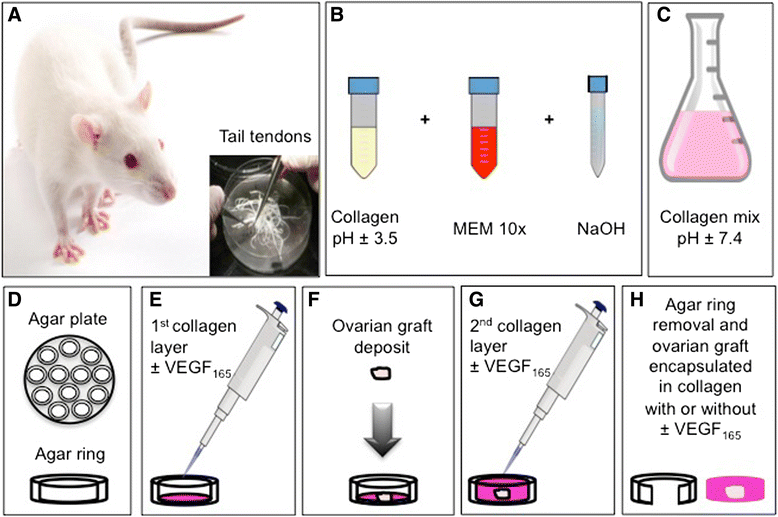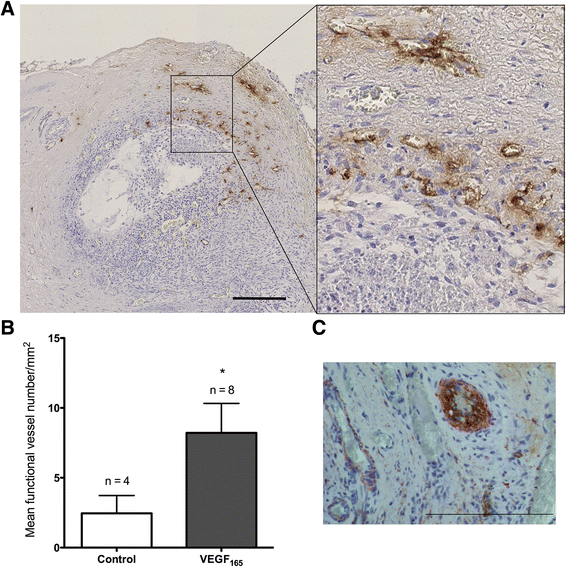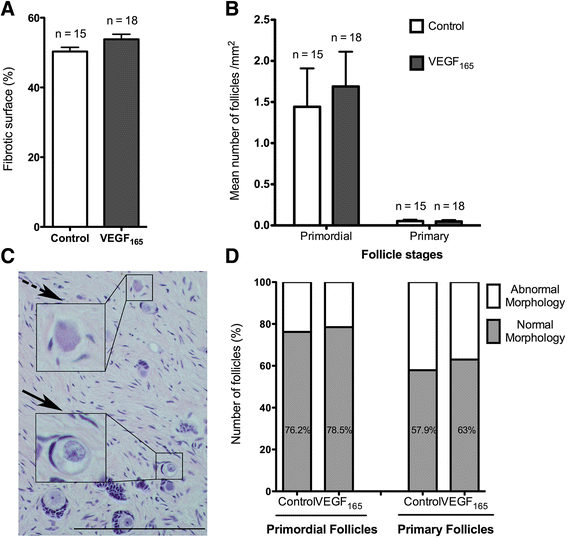Isoform 165 of vascular endothelial growth factor in collagen matrix improves ovine cryopreserved ovarian tissue revascularisation after xenotransplantation in mice
- PMID: 25888918
- PMCID: PMC4369824
- DOI: 10.1186/s12958-015-0015-2
Isoform 165 of vascular endothelial growth factor in collagen matrix improves ovine cryopreserved ovarian tissue revascularisation after xenotransplantation in mice
Abstract
Background: Aggressive anti-cancer treatments can result in ovarian failure. Ovarian cryopreservation has been developed to preserve the fertility of young women, but early graft revascularisation still requires improvement.
Methods: Frozen/thawed sheep ovarian cortical biopsies were embedded in collagen matrix with or without isoform 165 of vascular endothelial growth factor (VEGF165) and transplanted into ovaries of immunodeficient mice. Ovaries were chosen as transplantation sites to more closely resemble clinical conditions in which orthotopic transplantation has previously allowed several spontaneous pregnancies.
Results: We found that VEGF165 significantly increased the number of Dextran-FITC positive functional vessels 3 days after grafting. Dextran- fluorescein isothiocyanate (FITC) positive vessels were detectable in 53% and 29% of the mice in the VEGF-treated and control groups, respectively. Among these positive fragments, 50% in the treated group displayed mature smooth-muscle-actin-alpha (alpha-SMA) positive functional vessels compared with 0% in the control group. CD31 positive murine blood vessels were observed in 40% of the VEGF165 transplants compared with 21% of the controls. After 3 weeks, the density of murine vessels was significantly higher in the VEGF165 group.
Conclusion: The encapsulation of ovarian tissue in collagen matrix in the presence of VEGF165 before grafting has a positive effect on functional blood vessel recruitment. It can be considered as a useful technique to be improved and further developed before human clinical applications in female cancer patients in the context of fertility preservation.
Figures




Similar articles
-
Influence of mouse strain on ovarian tissue recovery after engraftment with angiogenic factor.J Ovarian Res. 2015 Mar 27;8:14. doi: 10.1186/s13048-015-0142-6. J Ovarian Res. 2015. PMID: 25824856 Free PMC article.
-
Isoform 111 of vascular endothelial growth factor (VEGF111) improves angiogenesis of ovarian tissue xenotransplantation.Transplantation. 2013 Feb 15;95(3):426-33. doi: 10.1097/TP.0b013e318279965c. Transplantation. 2013. PMID: 23380862
-
Adipose tissue-derived stem cells in a fibrin implant enhance neovascularization in a peritoneal grafting site: a potential way to improve ovarian tissue transplantation.Hum Reprod. 2018 Feb 1;33(2):270-279. doi: 10.1093/humrep/dex374. Hum Reprod. 2018. PMID: 29304240
-
Expectations and limitations of ovarian tissue transplantation.Zygote. 2017 Aug;25(4):391-403. doi: 10.1017/S0967199417000338. Epub 2017 Aug 2. Zygote. 2017. PMID: 28766468 Review.
-
Female fertility preservation strategies: cryopreservation and ovarian tissue in vitro culture, current state of the art and future perspectives.Zygote. 2016 Oct;24(5):635-53. doi: 10.1017/S096719941600006X. Epub 2016 May 4. Zygote. 2016. PMID: 27141985 Review.
Cited by
-
Age-related fertility decline: is there a role for elective ovarian tissue cryopreservation?Hum Reprod. 2022 Aug 25;37(9):1970-1979. doi: 10.1093/humrep/deac144. Hum Reprod. 2022. PMID: 35734904 Free PMC article. Review.
-
Thawing fertility: a view of ovarian tissue cryopreservation processes and review of ovarian transplant research.Fertil Steril. 2024 Oct;122(4):574-585. doi: 10.1016/j.fertnstert.2024.07.005. Epub 2024 Jul 9. Fertil Steril. 2024. PMID: 38992745 Review.
-
BEZ235-Mediated PI3K/mTOR dual inhibition improves ovarian follicle survival in a preclinical model.Reprod Biol Endocrinol. 2025 Jun 19;23(1):91. doi: 10.1186/s12958-025-01427-7. Reprod Biol Endocrinol. 2025. PMID: 40537830 Free PMC article.
-
Hypothermic machine perfusion after static cold storage improves ovarian function in rat ovarian tissue transplantation.J Assist Reprod Genet. 2020 Jul;37(7):1745-1753. doi: 10.1007/s10815-020-01797-4. Epub 2020 May 20. J Assist Reprod Genet. 2020. PMID: 32430732 Free PMC article.
-
Scaffold-based delivery of adipose tissue-derived stem cells in rat frozen-thawed ovarian autografts: preliminary studies in a rat model.J Assist Reprod Genet. 2015 Aug;32(8):1285-94. doi: 10.1007/s10815-015-0527-x. Epub 2015 Jul 24. J Assist Reprod Genet. 2015. PMID: 26206456 Free PMC article.
References
-
- Donnez J, Dolmans MM, Pellicer A, Diaz-Garcia C, Sanchez Serrano M, Schmidt KT, et al. Restoration of ovarian activity and pregnancy after transplantation of cryopreserved ovarian tissue: a review of 60 cases of reimplantation. Fertil Steril. 2013;99(6):1503–13. doi: 10.1016/j.fertnstert.2013.03.030. - DOI - PubMed
Publication types
MeSH terms
Substances
LinkOut - more resources
Full Text Sources
Other Literature Sources

